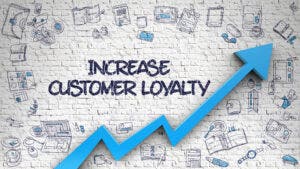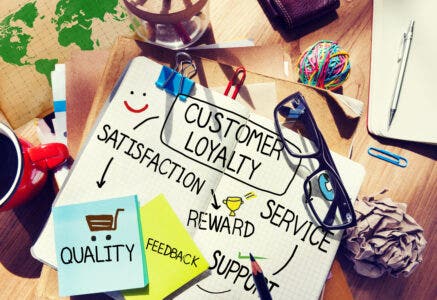Customer Loyalty Programs: Are They Worth the Effort?
At this point, it’s probably safe to say everyone is familiar with the concept of customer loyalty programs and loyalty rewards platforms. Most of us have grocery store savings club memberships, or frequent flyer miles, or gas station loyalty cards that save us a few cents at the pump or earn us free car washes.
Customer loyalty programs are popular with consumers in nearly every industry, for the same reason our customers at Tent and Table like our TNT Dynamite Rewards program: It’s a great way for our customers to earn all sorts of perks, including discounts on purchases, raffle entries, free equipment, and more.
How exactly do companies benefit from implementing these customer loyalty programs, though? Are they worth all of the effort it takes to create them? And just how much effort is actually involved in getting a loyalty rewards program off the ground? Is a small business rewards program right for my party rental company?
The Different Styles of Customer Loyalty Programs
Customer loyalty programs come in many different formats and styles, and there aren’t any real limitations on how a rewards program should be designed.
That having been said, we do see that some formats of customer loyalty programs are more common than others. Here are the “big three”; the three most popular styles of customer loyalty programs you’ll see frequently.
- Referrals: Discounts are earned for referring others to your company.
- Point Systems: Similar to our TNT Dynamite Rewards. The customer earns points for purchases, activity on social media, etc. and can then convert those points into coupons and freebies. Airlines offer points (frequent flyer miles) for distances traveled.
- Paid Membership: Think Amazon Prime or Newegg Premier. Members pay a monthly or yearly fee for access to free shipping, expedited processing, exclusive deals, and dedicated customer service. Not very relevant to party rental companies, of course.
How Does a Company Benefit from Offering Loyalty Rewards?
 We get that customers love these programs. Of course they do, right? They’re getting free stuff and discounts, mostly for things they were already planning on doing to begin with. But what’s the company’s take from all this? What benefits are reaped by businesses implementing customer loyalty programs?
We get that customers love these programs. Of course they do, right? They’re getting free stuff and discounts, mostly for things they were already planning on doing to begin with. But what’s the company’s take from all this? What benefits are reaped by businesses implementing customer loyalty programs?
At face value, the most obvious perk is the one most companies begin and end with: increased sales volume. Customers are more likely to spend money when there are incentives, beyond simple need fulfillment, to do so. And referrals programs can help bring in new customers and bolster sales even further.
Customer loyalty programs typically do generate decent returns on these two fronts. But there are other perks, too. And unfortunately, a lot of companies fail to recognize those additional benefits and never attempt to capitalize on them as a result.
If you’re making good use of spreadsheets and tracking customer data, customer loyalty programs can generate lots of useful information for you. And we hope you’re doing that, since we recently identified a failure to make good use of paperwork and spreadsheets as one of the 15 big mistakes party rental companies keep making.
Knowing when a customer is most likely to repeat their business is useful. Knowing that a certain type of promotion greatly increases the odds of their repeat business is invaluable.
Another perk rarely capitalized on by smaller companies running customer loyalty programs is their advantageous positioning for upselling. Consumers will typically spend more money when they feel like they’re saving money, and coupons trick consumers into spending more money than they planned to. Those savings your customer earned on their bounce house or party tent rental could be converted into sales opportunities for party tables, party chairs, dance floors, and more.
How to Successfully Implement a Customer Loyalty Program
Customer loyalty programs are pretty easy to get started … if you’re patient with them and do them the right way, that is.
Perhaps the most challenging aspect of developing customer loyalty programs is calculating a reasonable, profitable perks structure. You don’t want to make your discounts too extreme, but you don’t want to make them cheap and undesirable, either.
The goal is to strike a comfortable balance between customers getting value, the company developing opportunities, and avoiding financial loss. If you can hit all three of those goals, your customer loyalty program is doing what it’s supposed to do.
Another aspect you should take into consideration is your ability to gather valuable data from your rewards program. Create spreadsheets and use them to track not just points accumulated or referrals given, but also …
- Demographics: are certain neighborhoods more inclined to rent from you? What about age groups or genders? This data can help you focus your advertising efforts with laser-like precision, which is especially helpful for social media ad buys.
- Profit vs. loss per transaction, per customer, and per rewards tier
- Units most frequently rented using rewards
- Highest volume customers utilizing the rewards program
- Upsell volume and items tacked on to sales involving points
- Impacts on customer retention
- Total savings customers have earned, cumulatively (can be used for marketing the program itself)
Those are just a few of the valuable data points that can be collected from customer loyalty programs. An entrepreneur with the vision to utilize that data can transform their rewards program into a real cash cow thanks to all of this data they can collect.
The Downsides to Customer Loyalty Programs
Of course, not everything with customer loyalty programs is beneficial; they do have their shortcomings, and there are some reasons to not consider rolling out these types of platforms.
For starters, creating customer loyalty programs translates into a great deal of added work, especially if you’re going to track all of that data we mentioned in the last segment. And the volume of that work will increase as your rewards program expands.
You need to plan your rewards program from top to bottom, then implement it all into your website and social media, then market it, and then finally keep track of the data and analyze it for value. That might be too much to ask of a smaller company that already has a heavy workload.
The best idea for most party rental companies is probably that of scaling their customer loyalty programs over time. Start out with something simple—a basic referrals program, or perhaps a watered down points system with a few basic tiers. Make it clear that your rewards program can and will evolve over time and that rates are subject to changes. And as your company scales up, your rewards program is free to evolve to take whatever shape works best.
Would Customer Loyalty Programs Work for You?
Customer loyalty programs can be as simple as a referral program or an email sign up sheet, or as complex as a multi-tiered points system delivering mountains of customer data to your doorstep. How you develop your loyalty program will really boil down to your business style, your patience, your creativity, and your resources.
The golden rule is that your loyalty program needs to deliver for your business as well as it does for your customers, and vice versa. The benefits your company gains and the benefits your customers gain should relatively equal out. Systems that aren’t fair one way or the other won’t usually last.
You should ask yourself if you’d utilize your program if you were a customer patronizing another company with the exact same system. Would you think it was beneficial as a consumer? Would your savings be worthwhile? Do the benefits gained from the customer loyalty program make you feel more like a valued customer?
If customer loyalty programs are thought out and make customers feel appreciated, they often tend to work in most industries. In the party rental industry, customer loyalty programs are a little more complicated, and may not always match expectations. But a thoughtfully planned, reasonably-goaled customer loyalty program can and likely will deliver positive results for the right business leader.



Thanks again!